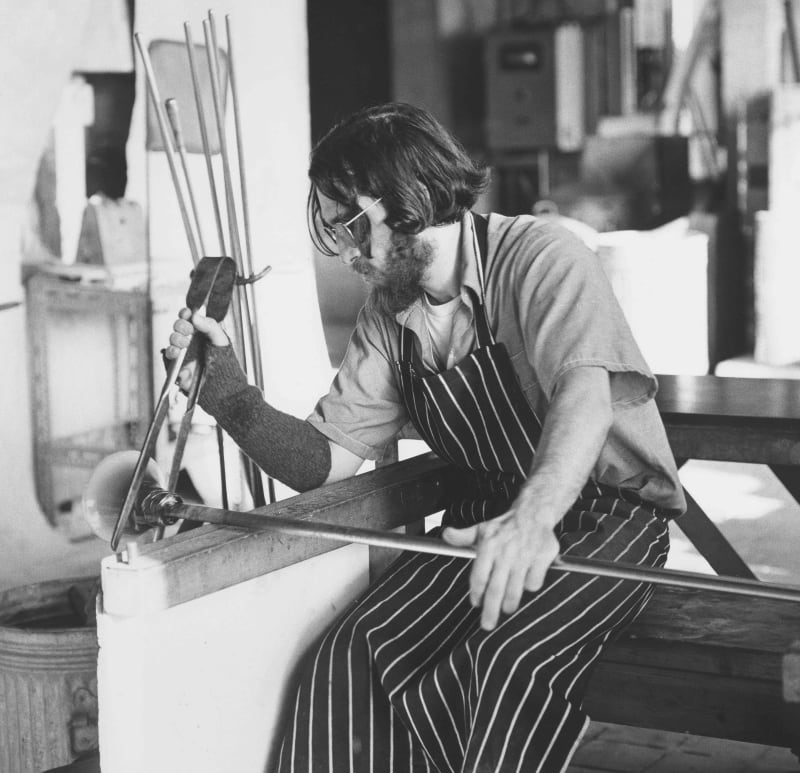Sam Herman (1936 - 2020) was a glass artist, painter and sculptor.
A true modernist, Herman stood at the very centre of the development of the Studio Glass Movement. He was not only present for the birth of the Movement, but he is its founding father in Great Britain and Australia. His influence is seminal - he inspired a generation of glass artists, developed revolutionary techniques and following his lead, colours in blown glass would become more textured and fluid.
Herman exhibited extensively throughout the world and his work is held in numerous public and private collections including, amongst many others, the Victoria & Albert Museum, Metropolitan Museum, Smithsonian, Art Institute of Chicago, Fitzwilliam Museum and the National Gallery of Victoria.
- The Studio Glass Movement and Sam -
The Studio Glass Movement revolutionised the understanding of glass as an art form. Up until the 1960s glass 'art' was based on the 'design and make' principle. A glass 'artist' would produce a 'design' and then hand it on to a craftsman glassblower who would 'make' the final work in an industrial sized furnace. This separation between designer and maker meant that there was little or no room for creative expression.
In 1962, in Wisconsin, Professor Harvey Littleton and Dominic Labino set out to break with this traditional model. They built a small tank-furnace, experimented with glass that would melt at lower temperatures and began developing new tools that would make it possible for the artist to have direct access to the material, ultimately allowing designer and maker to become one. Henceforth, the Studio Glass Movement was born.
That very same year, Herman enrolled at the University of Wisconsin. Initially, his Major was in sculpture with a Minor in ceramics, but during enrolment he met some students who were there to enrol on Harvey Littleton's new glass course. This exciting new programme immediately caught Herman's attention and he managed to persuade Littleton to take him on it. His fellow students included Marvin Lipofsky, Michael Boylen, Rodger Lang, Bill Boysen and Pat Esch and together they became the earliest adopters and developers of the Movement.
In 1965, Herman gained a Fulbright Scholarship to study at the Edinburgh College of Art. Whilst there he visited the glass and ceramics departments at Stourbridge and the Royal College of Art. That same year he organised an exhibition of the work of his Wisconsin alumni to travel around the UK to show these colleges the revolutionary developments taking place back in the US. Herman quickly caught the eye of David, the Marquess of Queensberry, the then head of the Ceramics and Glass Department at the RCA. Queensbury saw the incredible potential of Studio Glass and invited Herman to become a Research Fellow at the RCA. He accepted the position and in 1966 built a small tank furnace at the RCA, the first of its type in the UK. Herman remained at the RCA until 1974 as the Tutor in Charge of the Glass and Ceramics Department.
In 1969, Herman set up the celebrated Glasshouse in Covent Garden. He conceived it as "a workshop that would act as a halfway house between college and the real world, supporting artists in creating a life in glass away from industry". For the next thirty years the Glass House became a centre point for UK studio glass. In the words of the art historian Dan Klein "what is remarkable is that almost all who worked at the Glasshouse have in one way or another made a significant contribution to the world of glass, and each one in a very personal way".
In 1971, The Victoria and Albert Museum held a highly acclaimed exhibition of Herman's work, confirming his position as an innovator within his field and a master of his craft. At around the same time he agreed to produce a line of production work for the celebrated Belgian glass manufacturer Val St Lambert. Unsurprisingly this quickly caught the eye of the commercial galleries where he went on to have numerous shows in London, with amongst others, the Fine Art Society, as well as all across Europe and beyond.
In 1974, Herman was invited by the South Australian Government to set up the glass workshop at the Jam Factory in Adelaide, thereby bringing the Studio Glass Movement to their shores. He eventually returned to the UK in 1979 to set up a studio in Lots Road, London. In 1983 Herman became an Honorary Fellow of the Royal College of Art.
In 1984, Herman moved to the west coast of Mallorca, creating a home and studio in the Tramuntana Mountains high up above the Mediterranean Sea. Inspired by the awesome landscape and the atmosphere of this new territory, Herman took the radical decision to re-focus his talents on painting and sculpture, the path he had initally set out on before his meeting with Littleton. Since moving his studio to Mallorca, Herman was only occasionally persuaded to return to the furnace. One such occasion was in 2012, when he agreed to mark the 50th anniversary of the birth of the Studio Glass Movement by producing a limited edition of works at Peter Layton's London Glassblowing and then at Colin Hawkins' studio in Cirencester.
Herman's primitive painting style and sculpture work have been a revelation to his audience. Much of it is evidently influenced by his unique understanding of the nature of glass and colour, it consequently delighted in adding a new dimension to his ouevre.
Herman's work continues to inspire artists and collectors alike.
